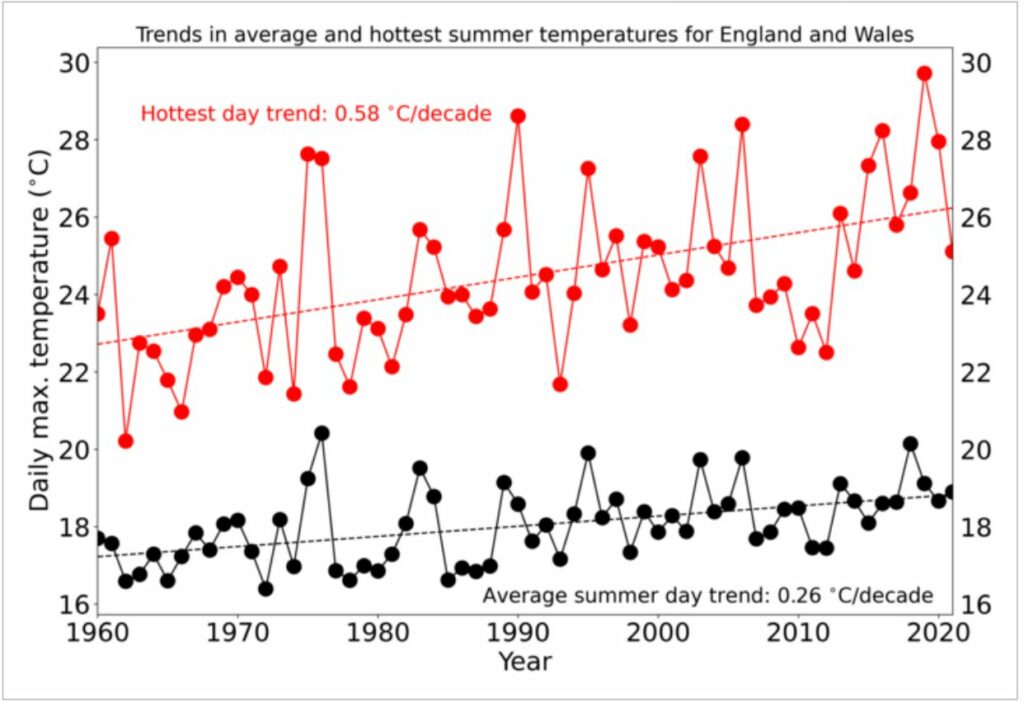A recent study led by the University of Oxford reveals that climate change is causing the hottest days in North-West Europe to warm at twice the speed of average summer days. The research, focused on England, Wales, and Northern France, highlights a concerning disparity between the warming trends observed on extreme heat days compared to climate models’ predictions.
Dr. Matthew Patterson, the lead researcher from the University of Oxford’s Department of Physics, emphasizes the significance of these findings. They suggest that extreme heat events, including the record-breaking heatwave experienced by the UK last summer, are likely to become more frequent occurrences. Dr. Patterson asserts that the UK and neighboring countries are already feeling the effects of climate change, dispelling any notion that last year’s heatwave was an isolated incident. Urgent action is required from policymakers to adapt infrastructure and healthcare systems in order to effectively mitigate the impacts of rising temperatures.
The study, published today in Geographical Research Letters, analyzed six decades’ worth of data (1960-2021) documenting maximum daily temperatures, provided by the European Centre for Medium-Range Weather Forecasts. The comprehensive analysis reinforces the need for immediate measures to address the escalating challenges posed by climate change in North-West Europe.
The rate of warming for the hottest days in North-West Europe has been found to be twice as fast as that of average summer days, despite variations in the maximum recorded temperatures between years. Analyses clearly indicate that while the average summer day in England and Wales has increased by approximately 0.26°C per decade, the temperature rise for the hottest day is around 0.58°C per decade. This accelerated warming of the hottest days, however, has not been observed to the same extent in other parts of the Northern Hemisphere.

The exact cause of this faster warming trend for the hottest days compared to average summer days is still not fully understood. Dr. Patterson suggests that it could be attributed to the fact that the hottest summer days in North-West Europe often coincide with the influx of hot air from Spain. As Spain experiences a faster rate of warming compared to North-West Europe, the air transported from that region becomes increasingly extreme relative to the ambient air in North-West Europe. In 2022, for example, the hottest days were driven by a plume of hot air originating from Spain and the Sahara. However, further research is required to validate this hypothesis and gain a deeper understanding of the phenomenon.
“Understanding the warming rate of the hottest days will be important if we are to improve climate model simulation of extreme events and make accurate predictions about the future intensity of such events,” adds Dr. Patterson.
“If our models underestimate the rise in extreme temperatures over the coming decades, we will underestimate the impacts this will have.”
Extreme heat has profound detrimental effects on various societal facets, encompassing energy and transportation infrastructure, as well as agriculture. Additionally, it worsens the prevalence of respiratory and cardiovascular ailments, consequently burdening healthcare services.
The present administration of the United Kingdom has faced criticism from the Climate Change Committee (CCC) due to its perceived sluggishness in taking prompt action to prepare for the repercussions of global warming. These fresh discoveries further emphasize the pressing need for policymakers to swiftly adapt vulnerable infrastructure and systems to combat the challenges posed by extreme heat.
Source: 10.1029/2023GL102757
Image Credit: Matthew Patterson, Department of Physics, University of Oxford / Featured Image by Jonathan Brady/PA Images via Getty Images
